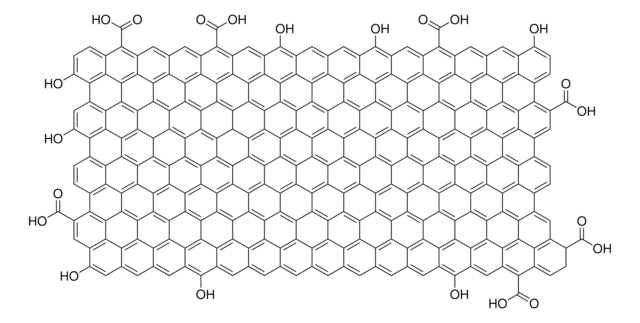791504
Carbon nanotube, single-walled
conductive aqueous ink, 0.9-1.1 mg/mL SWCNT(concentration by Absorbance at 854 nm)
Synonym(s):
CG300-Aqueous Ink, SWCNT Ink, SWNT Ink, SWeNT AC200, Single-Walled Carbon Nanotube Ink
About This Item
product name
Carbon nanotube, single-walled, conductive aqueous ink, 0.9-1.1 g/L (SWCNT concentration by Absorbance at 854 nm), avg. no. of layers, 1
form
dispersion in H2O (black liquid)
Quality Level
feature
avg. no. of layers 1
greener alternative product characteristics
Design for Energy Efficiency
Learn more about the Principles of Green Chemistry.
sustainability
Greener Alternative Product
concentration
0.9-1.1 g/L (SWCNT concentration by Absorbance at 854 nm)
sheet resistance
<600 Ω/sq, at 85% VLT (ohm/square) (by 4-point probe on prepared film by rod coating)
viscosity
3.0 mPa.s (at 10 sec-1 shear rate)
density
1 g/cm3
greener alternative category
, Enabling
Related Categories
General description
Application
Legal Information
Signis is a registered trademark of Chasm Advanced Materials, Inc.
CoMoCAT is a trademark of Chasm Advanced Materials, Inc.
CHASM is a trademark of Chasm Advanced Materials, Inc.
Signal Word
Warning
Hazard Statements
Precautionary Statements
Hazard Classifications
Aquatic Chronic 3 - Eye Irrit. 2
Storage Class Code
12 - Non Combustible Liquids
WGK
WGK 3
Flash Point(F)
Not applicable
Flash Point(C)
Not applicable
Certificates of Analysis (COA)
Search for Certificates of Analysis (COA) by entering the products Lot/Batch Number. Lot and Batch Numbers can be found on a product’s label following the words ‘Lot’ or ‘Batch’.
Already Own This Product?
Find documentation for the products that you have recently purchased in the Document Library.
Customers Also Viewed
Articles
The emerging field of printed electronics requires a suite of functional materials for applications including flexible and large-area displays, radio frequency identification tags, portable energy harvesting and storage, biomedical and environmental sensor arrays,5,6 and logic circuits.
Boron nitride nanotubes (BNNT) are close structural analogs of carbon nanotubes (CNT), which are high aspect ratio nanotubular material, where carbon atoms are alternately substituted by nitrogen and boron atoms.
Professor Rivnay (Northwestern University, USA) discusses using organic mixed conductors as an alternative to efficiently bridge the ionic world of biology with contemporary microelectronics.
A nanocomposite is typically defined as a mixture between a host material (e.g., polymer matrix) and nanofillers with at least one dimension of less than 100 nm.
Our team of scientists has experience in all areas of research including Life Science, Material Science, Chemical Synthesis, Chromatography, Analytical and many others.
Contact Technical Service

